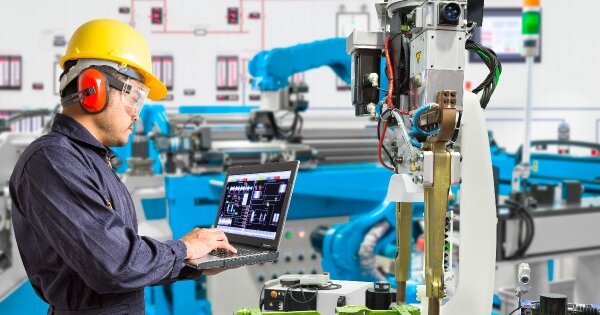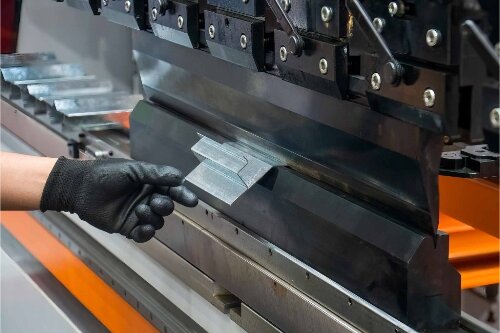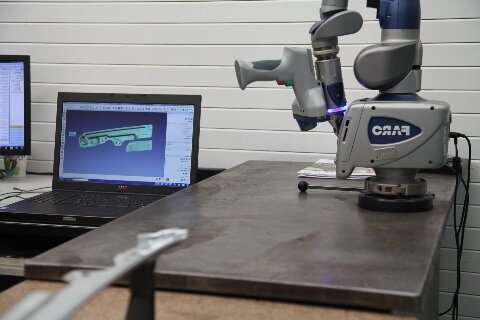Muchos proyectos de chapa metálica no siguen un camino recto. Los diseños cambian. Los mercados cambian. Los clientes también quieren muestras antes de que el utillaje esté listo. Muchos equipos se sienten atrapados entre los lentos prototipos y la costosa producción en serie.
La producción puente ofrece a los equipos una opción intermedia. Ofrece piezas originales, plazos de entrega rápidos y sin costes iniciales de utillaje. Esta guía explica qué es la producción puente y cuándo es más eficaz. También muestra cómo pasar de la producción puente a la producción completa con menos riesgos.

¿Qué es la producción de puentes?
La producción puente es un método intermedio entre la creación de prototipos y la producción en serie. La fábrica utiliza una serie de herramientas flexibles, como el corte por láser, el punzonado CNC, el plegado y la soldadura. En esta fase, la fábrica no utiliza matrices de estampación ni matrices progresivas.
Las piezas puente suelen coincidir con los materiales y formas de la producción real. Los ingenieros pueden comprobar antes el ajuste y la resistencia. Los compradores pueden ver los costes reales y planificar con más eficacia. La producción de puentes suele implicar lotes pequeños o medianos, desde unas pocas docenas a unos pocos miles de piezas.
La producción puente funciona bien para la chapa metálica porque las máquinas digitales pueden actualizarse rápidamente. Un cambio en un archivo CAD puede trasladarse a las máquinas en cuestión de minutos. Esto hace que los cambios de diseño sean fáciles y seguros.
Por qué los proyectos de chapa metálica suelen necesitar una fase puente?
Muchas piezas de chapa metálica necesitan varias rondas de actualizaciones. A menudo, los ingenieros no descubren los problemas hasta después de sujetar la primera pieza fundamental. Puede que algunas piezas no encajen. Es posible que algunos dobleces no se formen limpiamente. Algunos agujeros necesitan pequeños cambios.
La producción de puentes mantiene el proyecto en marcha mientras los ingenieros trabajan para resolver estos problemas.
El utillaje tarda demasiado
Los troqueles de estampación suelen necesitar de 6 a 10 semanas o más. Muchos equipos no pueden esperar tanto. La producción puente permite fabricar piezas rápidamente sin tener que esperar a los utillajes.
Los costes de utillaje son elevados cuando los diseños no son estables
El utillaje puede costar miles de dólares. Si la pieza cambia más tarde, el equipo debe arreglar o reconstruir el utillaje. Esto aumenta el coste y el retraso. La producción puente evita este riesgo inicial.
La demanda no está clara en los primeros meses
Los nuevos productos suelen empezar poco a poco. Un equipo puede necesitar 50 piezas ahora y 300 el mes que viene. Pero nadie sabe si la demanda alcanzará las 20.000 unidades anuales. La producción puente cubre esta incertidumbre inicial.
Las cadenas de suministro pueden cambiar
Algunas empresas cambian de proveedor o de ubicación. Otras pueden sufrir retrasos en los envíos. La producción puente ayuda a mantener las piezas en movimiento mientras se establecen los planes a largo plazo.

Principales ventajas de la producción de puentes
La producción puente ofrece plazos más rápidos, menos riesgos y más control. Los detalles que figuran a continuación desglosan estas ventajas en puntos sencillos.
Entrega rápida
La producción puente corta las piezas con rapidez. Muchos talleres pueden entregar el primer lote en menos de una semana. Esta rapidez permite a los equipos de ingeniería realizar pruebas y avanzar sin demora.
Menor riesgo precoz
La producción puente elimina los costes de utillaje por adelantado. Los equipos pueden esperar hasta que se sientan preparados antes de pagar el utillaje. Esto reduce el riesgo financiero.
Cambios de diseño sencillos
La producción de puentes simplifica las actualizaciones de diseño. Los ingenieros cambian el archivo CAD. La fábrica actualiza los programas y continúa la producción. No es necesario cambiar las herramientas.
Mejor control durante las primeras construcciones
Los flujos de trabajo puente se mantienen estables incluso cuando las cantidades fluctúan. La fábrica puede añadir unidades rápidamente o reducir la velocidad si cambian los planes.
Bueno para pruebas piloto
Las piezas de la producción puente están fabricadas con materiales reales. Funcionan bien para EVT, DVT, PVT y las primeras muestras de clientes.
Limitaciones de la producción de puentes
La producción de puentes tiene límites que importan para los planes a largo plazo. Las notas siguientes explican cuándo el método puede dejar de ser adecuado.
Mayor coste por pieza
Corte por láser y flexión cuestan más por pieza que la estampación. Cuando la necesidad anual crece, el utillaje se abarata.
Una regla sencilla es:
- En 2.000 unidades/año → el puente es bueno
- En 8.000 unidades/año → las herramientas son mejores
Algunas formas necesitan utillaje
Las piezas embutidas, los bordes curvos y las formas complejas suelen requerir utillaje especializado. La producción puente no siempre puede fabricar estas formas a bajo coste.
Diferentes aspectos o tolerancias
Las piezas puente pueden tener radios de curvatura diferentes o pequeñas marcas de soldadura. Las piezas mecanizadas pueden parecer más lisas. Los equipos deben comprobar estas diferencias con antelación.
Cómo decidir si la producción de puentes se adapta a su proyecto?
La producción puente es una opción viable, pero puede no ser adecuada para todos los planes. Los puntos siguientes ofrecen una forma sencilla de determinar si se ajusta a sus necesidades.
Compruebe su cronología
Su calendario debe guiar su elección. Si no puede esperar de 6 a 10 semanas para el utillaje, la producción puente le ofrece piezas mucho más rápido.
Calcular el volumen del primer año
El volumen previsto suele decidir cuál es el mejor camino. Si planeas construir cantidades pequeñas o inciertas, la producción puente mantiene tu riesgo bajo.
Considere la estabilidad de su diseño
Su diseño debe ser estable antes de invertir en utillaje. Si aún así pueden producirse cambios, la producción puente le protege de costosas repeticiones.
Comparar costes
He aquí un ejemplo sencillo:
- Coste del utillaje: $12,000
- Parte del puente: $18 por unidad
- Pieza labrada: $4 por unidad
El umbral de rentabilidad se sitúa en torno a las 1.000-1.200 unidades. Por debajo de esta cifra, la producción de puentes es más barata.
Piense en el riesgo de la cadena de suministro
Si su cadena de suministro es cambiante o inestable, la producción puente le ayuda a evitar retrasos.
Cómo funciona la producción de puentes en una fábrica de chapas?
La producción puente utiliza herramientas flexibles y configuraciones rápidas para fabricar piezas originales sin necesidad de utillaje. Los siguientes pasos describen el proceso por el que una fábrica fabrica estas piezas de principio a fin.
Corte por láser o punzonado CNC
La fábrica empieza cortando patrones planos a partir de láminas de material. Corte por láser es adecuado para formas detalladas, mientras que Punzonado CNC es más rápido para crear agujeros repetidos o formas simples.
Doblar
A continuación, el equipo da forma a las piezas cortadas en una prensa plegadora. Las máquinas utilizan programas sencillos que permiten a los ingenieros actualizar los ángulos de curvatura o el tamaño de las bridas en un tiempo mínimo.
Soldadura y montaje
Los trabajadores unen las piezas con soldaduras, remaches, o hardware. Estos pasos ayudan a confirmar la resistencia, el ajuste y asamblea antes de que el diseño pase a utillaje.
Acabado
Las piezas reciben revestimiento o tratamiento de superficiecomo el recubrimiento de polvo, el anodizado o el chapado. Esto ayuda a los equipos a comprobar el color final, la textura y la durabilidad.

Estructura de costes de la producción de puentes
La producción de puentes sigue un patrón de costes simple basado en el tiempo y la mano de obra. El desglose que figura a continuación describe los factores que determinan el precio y ofrece orientación para la planificación.
Los costes de producción de puentes dependen de:
- Tiempo de máquina
- Tiempo de trabajo
- Hardware
- Acabado
- Tamaño del lote
No hay costes de utillaje, por lo que los precios son sencillos y se basan en el tiempo de procesamiento.
Cómo pasar de la producción puente a la producción completa?
Para pasar sin problemas de la fabricación de series cortas al utillaje hay que seguir unos pasos claros. Los puntos siguientes le ayudarán a bloquear el diseño, planificar el utillaje y evitar retrasos en el suministro.
Paso 1: Confirmar el diseño
Debe utilizar piezas puente para comprobar el ajuste, la resistencia, el calor y el montaje. Un diseño estable reduce el riesgo cuando se pasa al utillaje.
Paso 2: Identificar las funciones que necesitan utillaje
Debe buscar formas que no puedan realizarse bien con corte y plegado. Estas características suelen necesitar troqueles reales en la siguiente fase.
Paso 3: Iniciar la fabricación de herramientas mientras continúa la construcción de puentes
Debe mantener la producción puente en marcha mientras se fabrica el utillaje. Este solapamiento garantiza que los pedidos sigan avanzando y evita lagunas en el suministro.
Paso 4: Inspeccionar las muestras de utillaje
Debe comprobar el tamaño, la forma y el acabado de las primeras piezas mecanizadas. Las correcciones deben llevarse a cabo antes de iniciar las tiradas de gran volumen.
Paso 5: Cambie la producción lentamente
Hay que pasar de la construcción de puentes a la fabricación de herramientas en pequeños pasos. Así el equipo tendrá tiempo de confirmar la calidad y proteger la entrega.
Conclusión
La producción puente ofrece a los equipos velocidad, flexibilidad y menor riesgo. Ayuda a que los proyectos avancen incluso cuando los diseños siguen cambiando. También mantiene una entrega constante cuando el utillaje no está listo. Muchos equipos utilizan la producción puente como la vía más segura para pasar de las primeras construcciones a la producción total.
Para determinar si la producción en puente es adecuada para su pieza de chapa metálica, puedes compartir tus dibujos o archivos STEP para una revisión rápida. Una breve revisión puede revelar el plazo de entrega, el umbral de rentabilidad y el momento óptimo para la transición al utillaje.
Hola, soy Kevin Lee

Durante los últimos 10 años, he estado inmerso en diversas formas de fabricación de chapa metálica, compartiendo aquí ideas interesantes de mis experiencias en diversos talleres.
Póngase en contacto

Kevin Lee
Tengo más de diez años de experiencia profesional en la fabricación de chapas metálicas, especializada en corte por láser, plegado, soldadura y técnicas de tratamiento de superficies. Como Director Técnico de Shengen, me comprometo a resolver complejos retos de fabricación y a impulsar la innovación y la calidad en cada proyecto.




